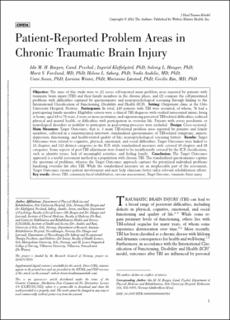| dc.contributor.author | Borgen, Ida Maria Henriksen | |
| dc.contributor.author | Kleffelgård, Ingerid | |
| dc.contributor.author | Hauger, Solveig Lægreid | |
| dc.contributor.author | Forslund, Marit Vindal | |
| dc.contributor.author | Søberg, Helene L. | |
| dc.contributor.author | Andelic, Nada | |
| dc.contributor.author | Sveen, Unni | |
| dc.contributor.author | Winter, Larraine | |
| dc.contributor.author | Løvstad, Marianne | |
| dc.contributor.author | Røe, Cecilie | |
| dc.date.accessioned | 2022-03-21T12:18:38Z | |
| dc.date.available | 2022-03-21T12:18:38Z | |
| dc.date.created | 2022-01-18T13:47:56Z | |
| dc.date.issued | 2021-11-02 | |
| dc.identifier.citation | The journal of head trauma rehabilitation. 2021, 2021 (Nov), . | en_US |
| dc.identifier.issn | 0885-9701 | |
| dc.identifier.issn | 1550-509X | |
| dc.identifier.uri | https://hdl.handle.net/11250/2986467 | |
| dc.description.abstract | Objective: The aims of this study were to (1) assess self-reported main problem areas reported by patients with traumatic brain injury (TBI) and their family members in the chronic phase, and (2) compare the self-prioritized problems with difficulties captured by questionnaires and neuropsychological screening through linking to the International Classification of Functioning, Disability and Health (ICF).
Setting: Outpatient clinic at the Oslo University Hospital, Norway.
Participants: In total, 120 patients with TBI were recruited, of whom, 78 had a participating family member. Eligibility criteria were a clinical TBI diagnosis with verified intracranial injury, living at home, aged 18 to 72 years, 2 years or more postinjury, and experiencing perceived TBI-related difficulties, reduced physical and mental health, or difficulties with participation in everyday life. Patients with severe psychiatric or neurological disorders or inability to participate in goal-setting processes were excluded.
Design: Cross-sectional.
Main Measures: Target Outcomes, that is, 3 main TBI-related problem areas reported by patients and family members, collected in a semistructured interview; standardized questionnaires of TBI-related symptoms, anxiety, depression, functioning, and health-related quality of life; neuropsychological screening battery.
Results: Target Outcomes were related to cognitive, physical, emotional, and social difficulties. Target Outcomes were linked to 12 chapters and 112 distinct categories in the ICF, while standardized measures only covered 10 chapters and 28 categories. Some aspects of post-TBI adjustment were found to be insufficiently covered by the ICF classification, such as identity issues, lack of meaningful activities, and feeling lonely.
Conclusion: The Target Outcomes approach is a useful assessment method in a population with chronic TBI. The standardized questionnaires capture the spectrum of problems, whereas the Target Outcomes approach captures the prioritized individual problems hindering everyday life after TBI. While the standardized measures are an irreplaceable part of the assessment, Target Outcomes ensures patient involvement and may help clinicians better tailor relevant rehabilitation efforts. | en_US |
| dc.description.sponsorship | The project is funded by the Research Council of Norway, project no. 260673/H10. | en_US |
| dc.language.iso | eng | en_US |
| dc.publisher | Lippincott, Williams & Wilkins | en_US |
| dc.relation.ispartofseries | The journal of head trauma rehabilitation; | |
| dc.rights | Attribution-NonCommercial-NoDerivatives 4.0 Internasjonal | * |
| dc.rights.uri | http://creativecommons.org/licenses/by-nc-nd/4.0/deed.no | * |
| dc.subject | Chronic traumatic brain injuries | en_US |
| dc.subject | Community-based rehabilitation | en_US |
| dc.subject | Outcome measurements | en_US |
| dc.subject | Target Outcomes | en_US |
| dc.subject | Traumatic brain injuries | en_US |
| dc.title | Patient-Reported Problem Areas in Chronic Traumatic Brain Injury | en_US |
| dc.type | Peer reviewed | en_US |
| dc.type | Journal article | en_US |
| dc.description.version | publishedVersion | en_US |
| dc.rights.holder | © 2021 The Authors | en_US |
| cristin.ispublished | true | |
| cristin.fulltext | original | |
| cristin.qualitycode | 1 | |
| dc.identifier.doi | https://doi.org/10.1097/HTR.0000000000000744 | |
| dc.identifier.cristin | 1983630 | |
| dc.source.journal | The journal of head trauma rehabilitation | en_US |
| dc.source.pagenumber | 1-10 | en_US |
| dc.relation.project | Norges forskningsråd: 260673/H10. | en_US |

